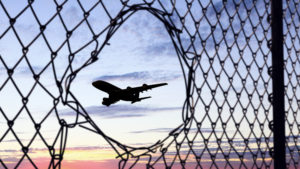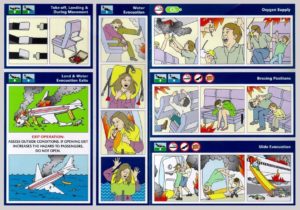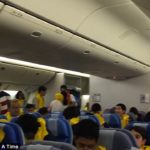I also take the time to locate the exit behind me, counting the rows to that exit so I can find it with my eyes closed by feeling seats as I crawl. Overkill? Maybe, but you know what? I am just not that important that I need my nose stuck in my device answering text messages or emails from members of the national security council.  Really amazes me how many important people there are around me though.
Really amazes me how many important people there are around me though.
When I sit in an exit seat I always double check the door opening system, just in case. This is where the genesis for this post comes in. I was recently flying on a major airline other than Delta. The safety briefing wording for those of us sitting in the exit row was a little different. I’m used to hearing the following questions that they need a verbal response – Do you realize you are sitting in an exit row? In the event of an emergency are you willing and able to assist by opening the door and helping others? Everyone says yes and then the flight attendant let’s us know there is a safety card in the seat pocket available for us to take a look at.
On this particular flight I am the first one to take a seat in the exit row. I did my normal of checking out the door opening system as the aircraft type is one I am familiar with. My fellow exit seaters take their place and in time the flight attendant comes to brief us. They start in with “You are sitting in an exit row and I need verbal confirmation to two questions.” I’m excited because I think I can pass this pop quiz. They throw me a curve ball, “Have you all had a chance to read your safety information card?”  I’m thinking to myself, that’s an odd question. I sat down first and none of us had read the card. Yet when the flight attendant turns and ask each person if they had read it, they all answer yes. I’m staring at them like…should I throw the BS flag here? The attendant looks at me with an expectant look and I say, “to be honest I have not.
I’m thinking to myself, that’s an odd question. I sat down first and none of us had read the card. Yet when the flight attendant turns and ask each person if they had read it, they all answer yes. I’m staring at them like…should I throw the BS flag here? The attendant looks at me with an expectant look and I say, “to be honest I have not.
The flight attendant stares at me like I have just expelled gas at the dinner table with the queen of England. They shake their head disapprovingly and say, “I’ll come back.” The sulk towards the back of the plane where I alone pull out my card and go through it. I can’t find any spelling errors and the flight attendant returns, hoping I have learned the errors of my ways. This time I can answer the question yes and pass the test. So my question to my readers is, “Is this just cheap talk?” Do we all just “wink wink”, read the booklet? What kind of crap is that? If the plane lands anywhere but at an airport, we need to get out these doors. Are the odds low? Yes. Air travel is incredibly safe, but it is not 100%.
I think there are a couple of problems here. The first is the wording of this airline’s question number one. Instead of asking a question that they know they will get a dishonest answer to, change the wording. If the question really means, have you ever read a safety booklet like this in your lifetime, say it. Better yet just encourage passengers to read the safety booklet. How? By adding in a simple code in 10% of the booklets that the reader can plug into their next ticket purchase and get a $50 off reward. Chances are few will follow through but even if some do, it’s a small percentage of the ticket cost and it could actually enhance safety compliance greatly. Even putting a word search puzzle inside it or find Captain Waldo would be more fun and get people to actually look at it.
I’m more into negative reinforcement so I would rather have electrical wiring in the seat that continues to increase in voltage until the booklet is removed from the seat pocket in front of you.  Better yet, every once in a while let’s do a drill. Ferries do it, why not planes? People are all snugged in their seats, waiting for take-off, reading, listening to music, still texting and writing emails when an over-head page comes on…”This is an exercise of your knowledge of aircraft emergency procedures. DON YOUR LIFE JACKETS….DON YOUR LIFE JACKETS. This is an exercise.” Now the key here is peer pressure. We don’t get to take off until everyone had managed to get their life jacket on, off and re-stored.
Better yet, every once in a while let’s do a drill. Ferries do it, why not planes? People are all snugged in their seats, waiting for take-off, reading, listening to music, still texting and writing emails when an over-head page comes on…”This is an exercise of your knowledge of aircraft emergency procedures. DON YOUR LIFE JACKETS….DON YOUR LIFE JACKETS. This is an exercise.” Now the key here is peer pressure. We don’t get to take off until everyone had managed to get their life jacket on, off and re-stored.
Humans forget and get confused in the heat of the moment. If we’re pretending to read and practice safety information, we won’t even have the luxury of forgetting something. We never learned it in the first place! Any of my readers who are instructors know that people like to think they’re better at performing tasks, especially from memory recall, than they really are at performing them. If we as passengers view safety as such a “given” or something of low importance, maybe the flight crew should just chill out too. No more checklists or time in a simulator. Nothing ever happens and if it did, we’d figure it out because we’re the ALL POWERFUL HUMAN!
Next time you’re on a flight, pay attention to the safety briefing. It may be your eighth trip in two weeks, but the little kid sitting across the isle who’s parents are engrossed in their smart devices, might learn a life-saving lesson, from you.




Jan,
One of my favorite articles. Great points and I agree 100% with drills. It truly is a matter of life and death, yet flight attendants have become complacent with ensuring passengers are prepared. I say, just ask Capt Sulleys passengers who shared a landing in the Hudson.
Take care and stay safe!
Dusty